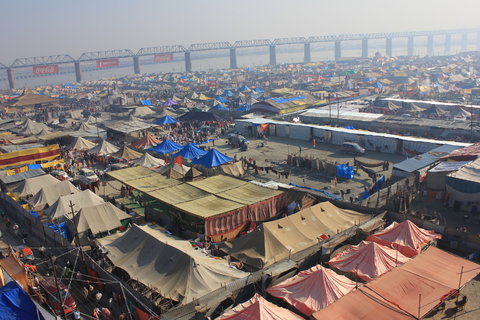Image: An aerial view of Kumbh Nagari, a cluster of makeshift tents erected for the Kumbh Mela in Allahabad.
ALLAHABAD, Uttar Pradesh—The sun rose on Leader Road, Allahabad, which leads to Allahabad Junction Railway Station, warming up a chilly Monday morning. Several local men had already begun to prepare generous shares of potato curry and puris to offer to Kumbh Mela pilgrims free of cost. As I stood at the corner of the street holding an early morning newspaper that reported on the stampede that had killed 36 people the previous night, a short, frail woman meekly approached me.
“How many are dead?” she asked, almost in a whisper. I told her that the paper was reporting 41, and she gasped and began to speak fast in Braj Bhasha, a dialect of Hindi that is spoken in western Uttar Pradesh. After asking her to repeat herself several times, I finally understood that she had been separated from her two children and her grandchildren for more than 24 hours. All that she had was a small cloth bag containing a sari and a torn piece of paper with her son’s mobile number on it. She was concerned about the safety of her family.
Speaking to her son on my phone, I learned that the family was safe and had left long ago. In fact, their train had already reached Agra, close to their home in Mathura.
As I accompanied the woman to the station to help her board the train to Mathura, several others who were stranded surrounded me began asking for train arrival and departure information. Most were on the wrong platforms and waiting for trains that were delayed by several hours or possibly even canceled. Distressed men looked for the women of their family, woman mourned lost toddlers and the elderly tried to cling to people from their village because their immediate families were nowhere in sight.
No matter whether they’ve come by air, rail or bus to the area, most pilgrims travel the final kilometers to Kumbh Nagari, the makeshift megacity that hosts the festival, largely by foot. On the day there was a stampede at the railway station, I arrived at 8 a.m. at the entrance to the Kali Marg, which is on the east side of Kumbh Nagari, and encountered a surreal sight – an ocean of humanity. An aerial view wouldn’t have shown a single inch of land on that street. Each one of the pilgrims was going to the Sangam, a confluence of Ganga, Yamuna and the mythical Sarasvati rivers, to take a dip on the day of Mauni Amavasya.
Mauni Amavasya is considered to be the biggest of the seven royal bathing days during the 55-day religious congregation that ends March 10. On this day, devotees maintain a maun vrat (silence), which is a particularly important aspect of spiritual discipline. It symbolizes a state of oneness with the self, and the initiation of an inner dialogue.
This Mauni Amavasya was especially important as the planets line up in such an auspicious manner only once every 144 years. Crowds were estimated to be three times the usual size on a shahi snan, or on any other royal bathing days. The more religious ones paced silently and conveyed messages to each other in sign language. Most of the others did not keep a vow of silence, but taking the holy dip on that day was of paramount importance to them.
After several minutes of being pulled along by the crowds toward the Sangam, I dragged myself out of the unending flow of people, sensing the danger of a stampede. Later, I learned there had indeed been a stampede on the very same spot on Kali Marg, which killed four. That tragedy would be overshadowed by the larger one several hours later at the railway station.
Apparently, 25,000 police and security forces, 250 doctors, 100 ambulances, five bomb squads and 200 police boats were insufficient to ensure the smooth functioning of the festival.
Stampedes have become an accepted part of the Kumbh Mela. They claimed seven lives during the 2010 Kumbh Mela, 39 in 2003 and in the worst Kumbh stampede since India’s independence, about 1,000 died in 1954.
This doesn’t stop an increasing number of people from swarming to the event. About 100 million people are expected to attend this year, almost a 30 percent increase from the last Kumbh at Haridwar.
That may seem like a huge number, but as one suave-looking devotee told me when I was at the railway station, “that is still less than 2 percent of the Indian population.”
Those that attend are privileged, she said. “The others are plain unlucky.”
Published in: NYT India Ink
Published on: 14 February, 2013
Link: http://india.blogs.nytimes.com/2013/02/14/faith-loss-luck-and-tragedy-at-the-kumbh-mela/


